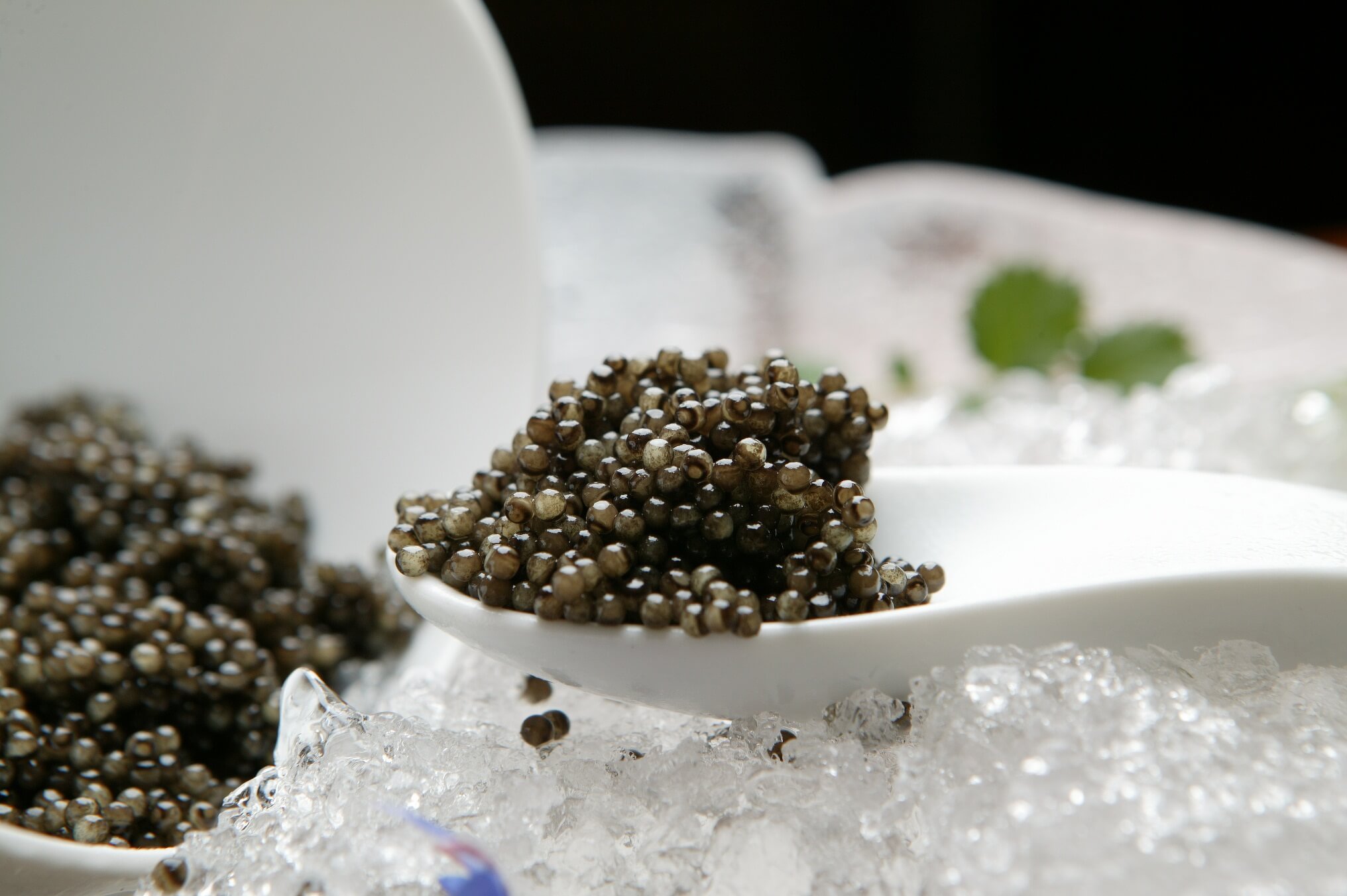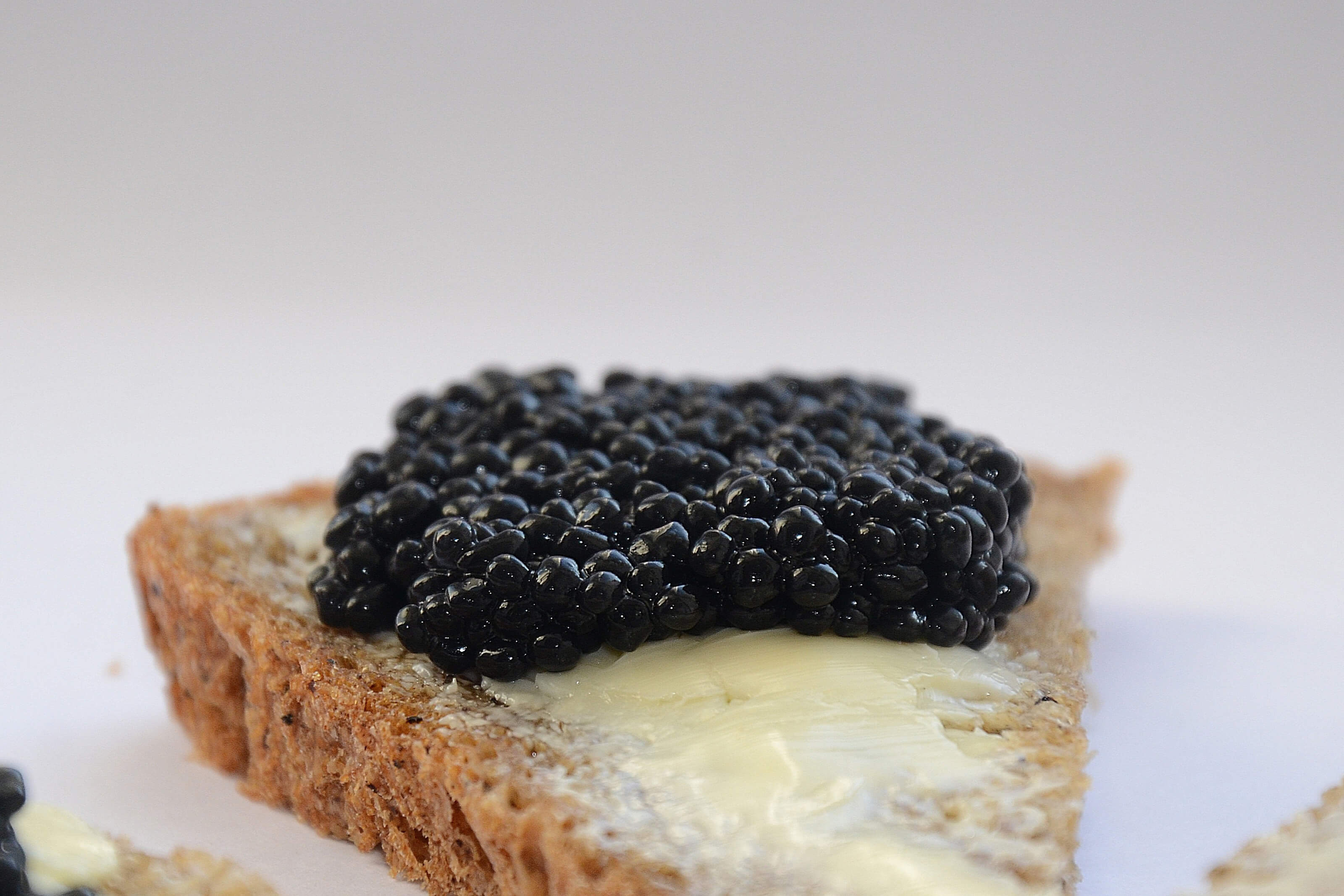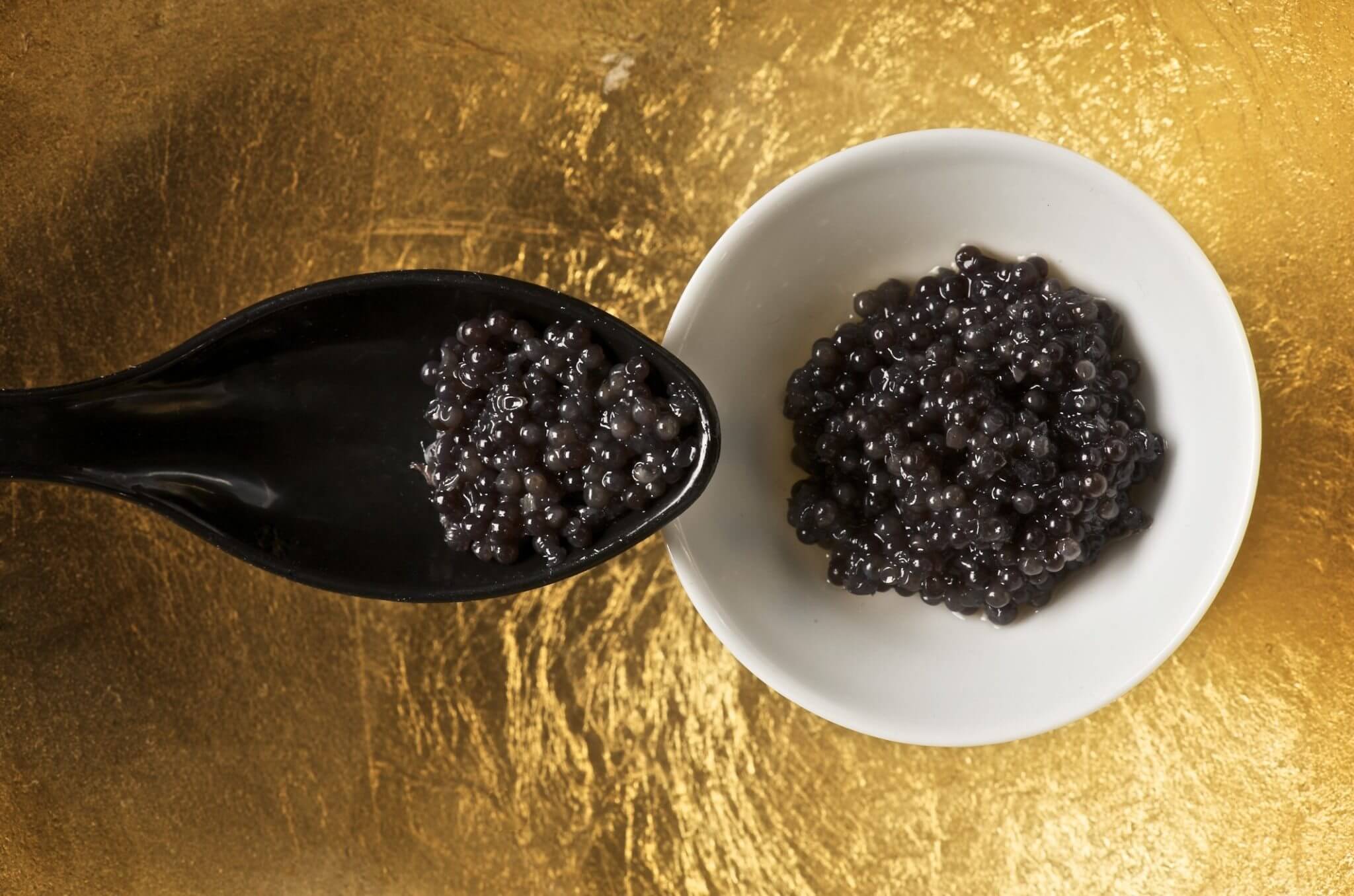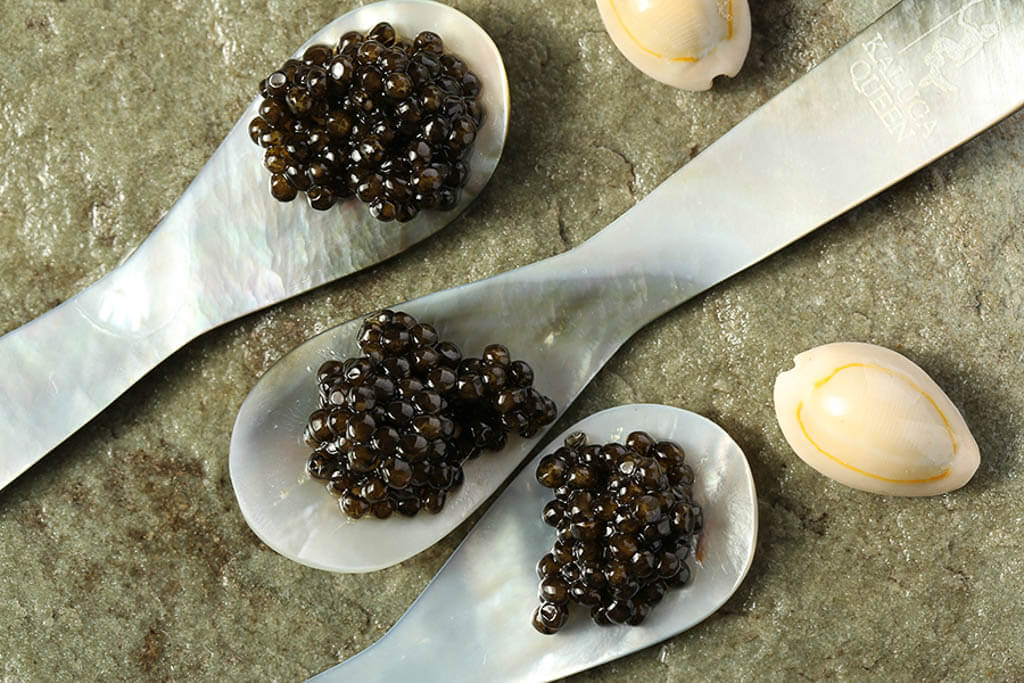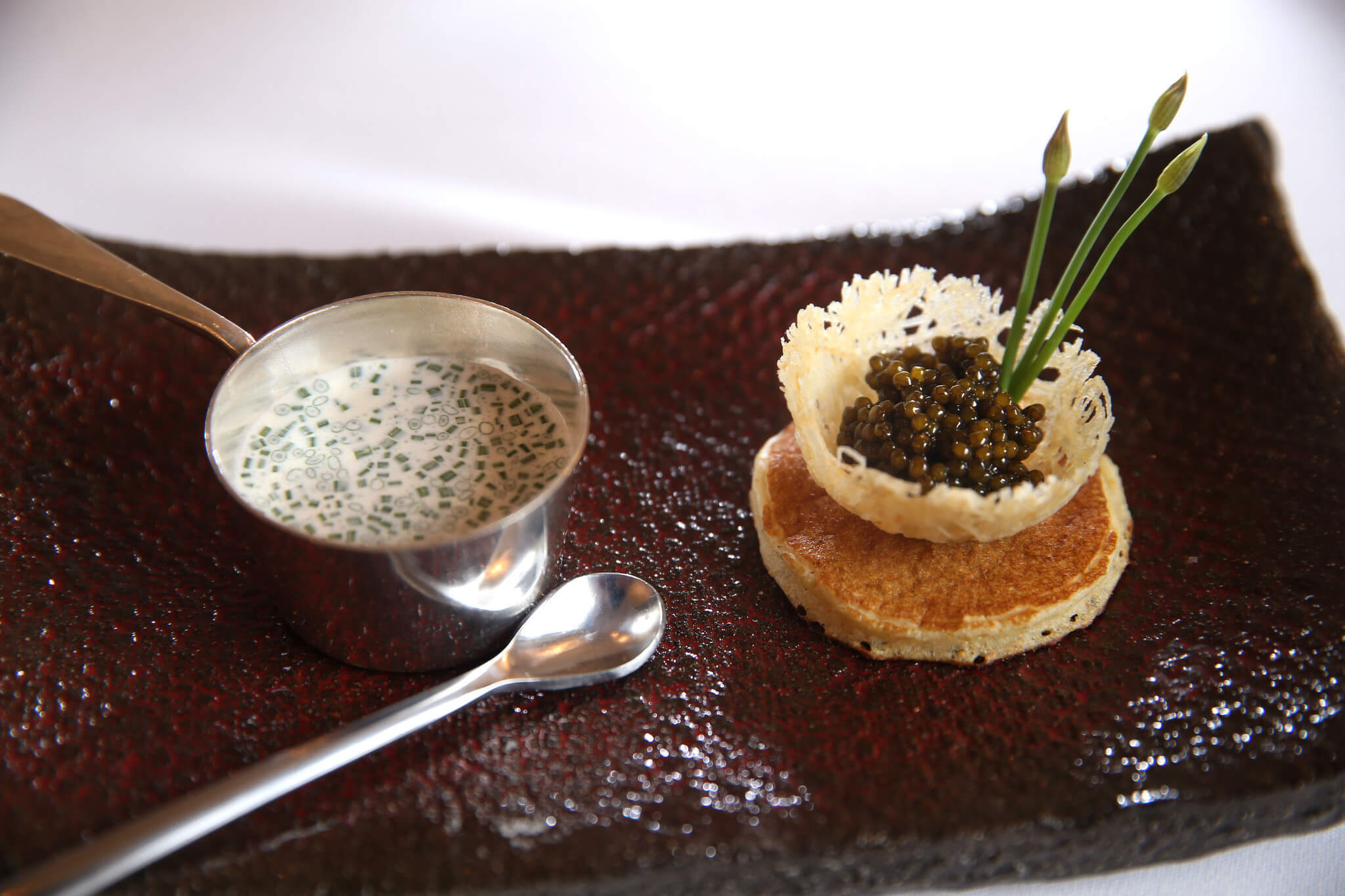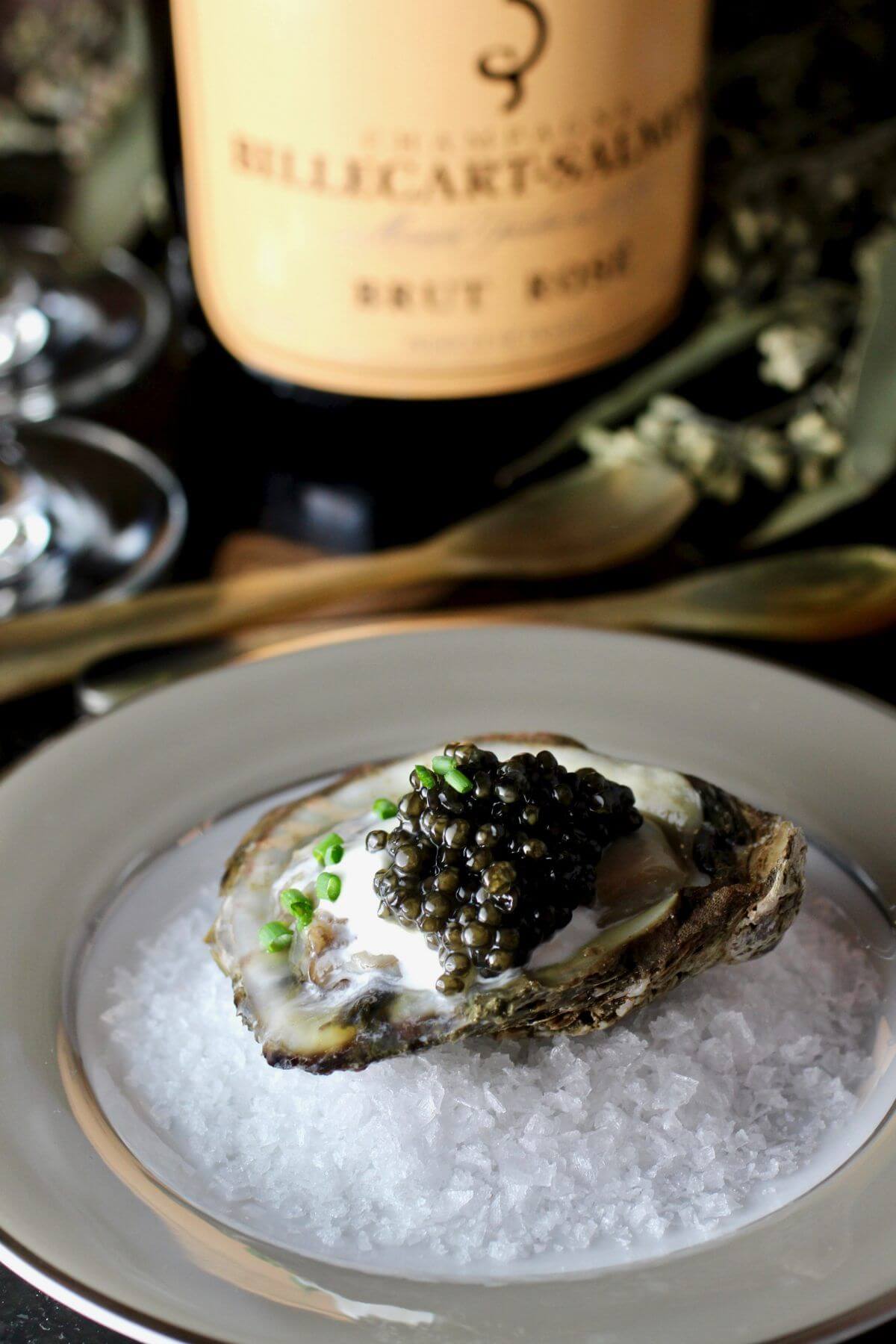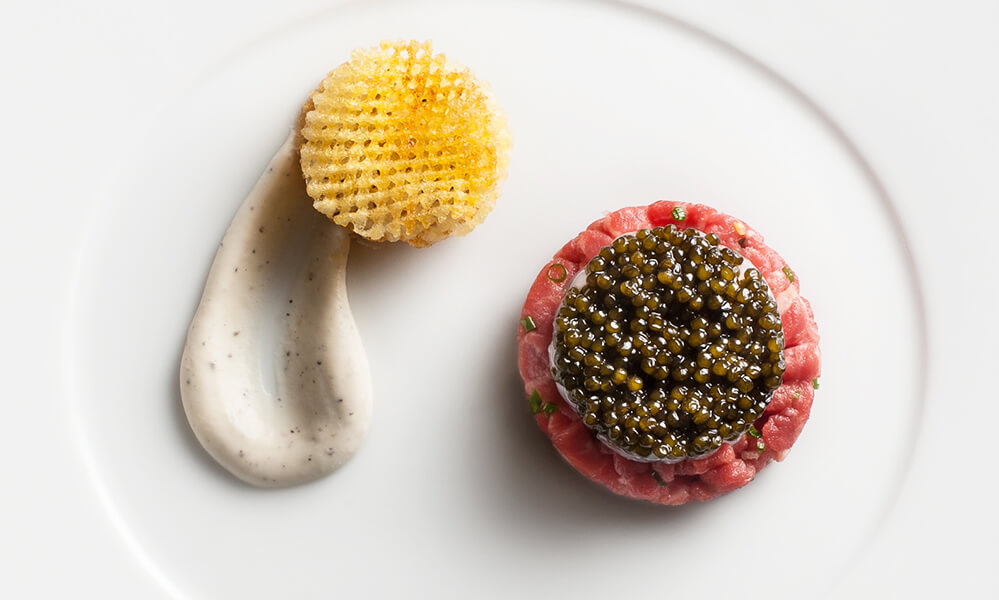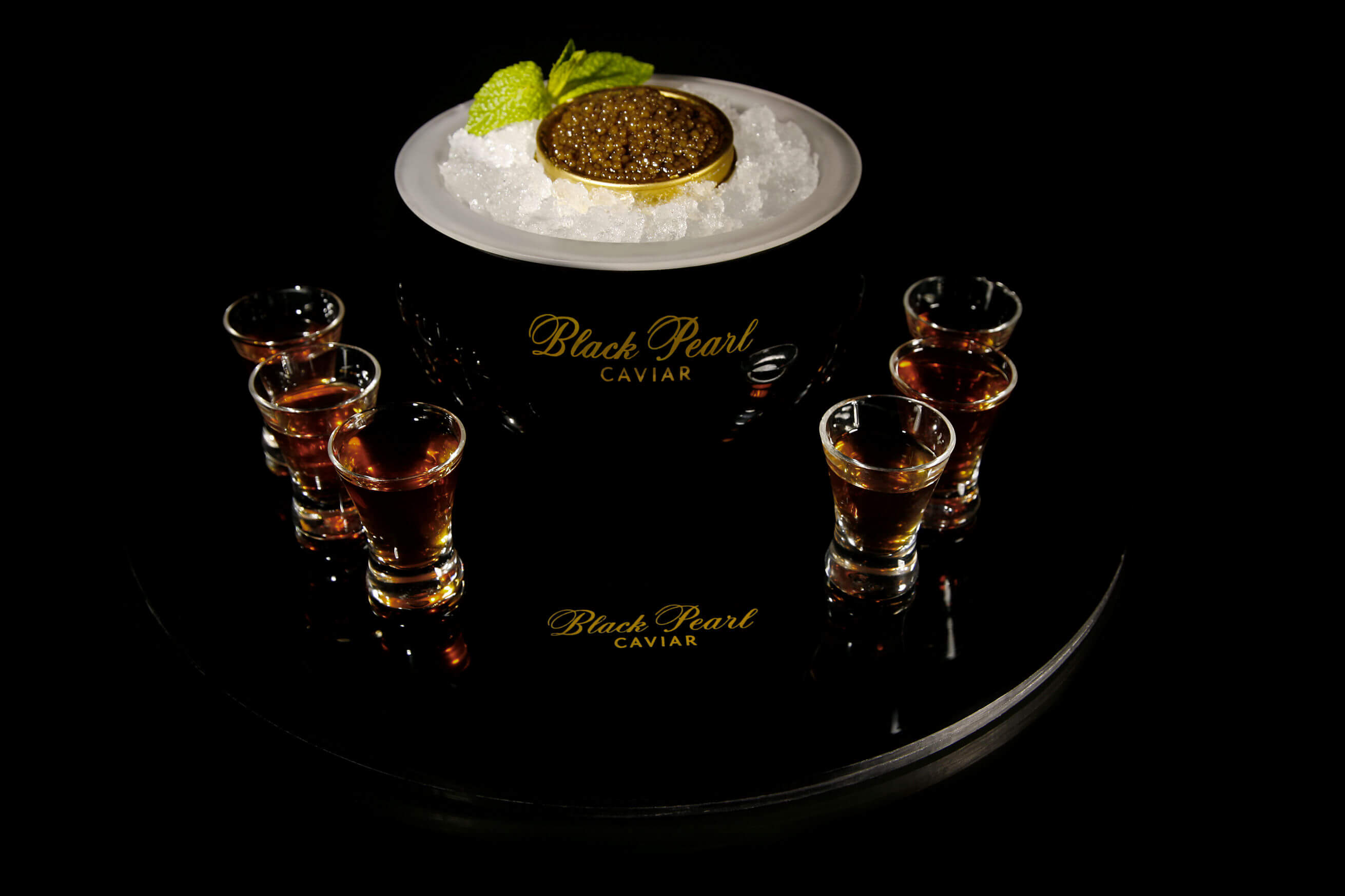At first glance, one may wonder how humble fish eggs can be so sought after, but true caviar is considered one of the finest delicacies and one of the most expensive foods in the world – with a namesake dating back to Aristotle, Marco Polo, and other such explorers made immortal in our history books (more about the history of caviar here. Caviar has long been synonymous with the luxurious way of life.
True caviar captures the epitome of the slow food movement. It’s the perfect storm of evolution and innovation. It is one of the oldest delicacies in the world. But few have unraveled the secret behind the source – so today we address the question – why is caviar so expensive?
The Source; A Waiting Game that Renders Caviar Expensive
To understand the rare and refined nature of the black pearls of the sea, you first have to go back to the art of production. The world’s best caviar comes from the endangered species of beluga sturgeon. The sturgeon fish is one of the oldest anadromous creatures to be found in the cold clear waters of the Caspian Sea. A mammoth and late maturing fish, the female beluga sturgeon can live for 118 years and doesn’t produce fish eggs for a cycle of at least 18 years. Farmers who are committed to sourcing the expensive food of beluga caviar are locked into a waiting game.
The Sturgeon; An Endangered Species
Beluga caviar has long been in demand, centuries of imports and exports have made the sturgeon fish an endangered species – especially in the sturgeons preferred playground of Iran’s Caspian Sea. Back in 2010, when the sturgeon population was reclassified and added to the endangered list, heavy production was halted, and Iran had to place countrywide controls on the industry.
Now, not only was the production of sourcing beluga caviar extremely slow due to the natural cycle of the sturgeon fish, but the restrictions on production and firm control of imports and exports led to further scarcity.
The Caspian Sea; Under Strict Duress
In an attempt to keep supply and demand high, other countries tried to farm their own beluga sturgeons, hoping for their own bloom of onyx fish eggs. However, the native brackish conditions of Iran’s Caspian Sea cannot be replicated in far-flung fish farms out in Florida or China, and the result will often be of sub-par standards.
Wild fishing for the beluga sturgeon has endured a massive clampdown, but Iran remains a place where sustainable farmed conditions are as close to wild fishing as the industry can ever hope to get. The highly coveted species of sturgeon are raised legally and under strict duress on Caspian Sea coastlines until the female roe is ready to be naturally harvested.
The Investment; Iran’s Most Precious Export
The caviar farms that dot the coastline are heavily regulated and backed by government revenue. There is no room for experimentation in this market – quality is everything. This high level of investment drives up the value and caviar has become Iran’s priciest export – even eclipsing the global power of oil. Iranian caviar has become a dynasty – with the Michelin Community all committed to sourcing Iranian when it comes to the fabled elixir ingredient.
The Result; A Perfect Storm
The reason as to why sturgeon caviar is so expensive seeps through many avenues of time, curated conditions, and finally the experience of taste. Pop a silver spoon into a jar of salt cured black pearl sturgeon caviar and the senses seem to come into perfect alignment.
There’s a soft creaminess to the palate, as delicate as freshly churned butter, enriched with earthy hues of walnut and the slight tang of cured fish, and a texture that is as round and silky as a perfect bottle of burgundy.
When you invest in the black pearls of the Caspian Sea you are purchasing the taste of centuries of commitment, decades of delicate tweaking, and years of love and waiting.
| Sturgeon Caviar Grading | |||||
| Quality Index | Evaluation Method | Highest Grade | Grade No.1 | Grade No.2 | Pasteurized² |
| Caviar origin & fish specie | Natural waters of Caspian Sea, CITES Label’ Quality certificates, Time-termperature history | Beluga, Osetra & Sevruga farmed using natural Caspian Sea Waters. Iran and Russia are the only two producers doing so. | Beluga, Osetra & Sevruga all other sturgeon species farmed using natural Caspian Sea Waters. Iran and Russia are the only two producers doing so. | Pasteurization is often not mentioned on the label. Species not intermixed | |
| Species not intermixed | Species may be intermixed | ||||
| Color | Visual, under standardized light condition | Homogeneous color. Beluga: light gray. Oscietre: slight yellowish or brownish shades in a basic gray-black hue. Beluga-white-gray and Oscietre- goldish shades are rarities | Homogeneous color. Light gray, dark gray, black, yellowish, brownish, greenish | Any color. Color mixtures acceptable | Any color. Slight color mixtures acceptable. Color may be paler than non-pasteurized |
| Appearance | Visual, over a candling table | Eggs round or slightly elongated, firm, elastic, easily separated, no broken eggs or residual tissue; reasonable moist and rotating inside a jar at room temperature | Eggs round or elongated but slightly weak; some presence of residual tissue; moist or dry & hardly rotating inside a jar at room temperature | Eggs weak and stick together in lumps; when separated eggs may burst; excessive juices released on container bottom or excessive dryness. Considerable number of burst eggs and membranes. Over-dried eggs | Eggs firmer than non-pasteurized eggs, easy to separate; presence of lumps and some juice acceptable |
Sturgeon and salmon roe are not very susceptible to efforts to redefine good flavor and texture because the perception of what constitutes good taste in these products is well established, see the tables below.
| Quality Index | Evaluation Method | Highest Grade³ | Grade No.1 | Grade No.2 | Pasteurized² |
| Egg Size³ | Line up eggs over a 10 cm ruler and measure | All eggs of one size, either large or medium | Eggs of any single size | Eggs size and mixture and acceptable | Eggs of any single size |
| Odor | Organoleptic, at room temperature | Typical for sturgeon, sweet & fresh; off-odors not acceptable | Weak typical sturgeon odor, no off-doors acceptable | Slight, sharp, sour, yeasty, stable off-odor acceptable | Typical for pasteurized sturgeon. Phenol odor |
| Offensive odors not acceptable | |||||
| Taste & Consistency | Organoleptic multiple tasting of small portions at chilled temperature | Typical for sturgeon yolky, delicate, grassy acceptable, rich and lasting. Egg membranes melt leaving a pleasant viscous liquid impression | Typical for sturgeon some loss of yolkiness& richness; grassy but not muddy or other non-offensive after-taste acceptable. Individual egg membranes are slightly recognizable. | Some sharpness; grassy or muddy after-taste acceptable. Slight bitter or sharp & sour aftertaste acceptable. Weak sturgeon flavour, not offensive, interfering flavours. Over-dried, recognizable dryness and total loss of the membrane melting phenomenon | Typical for pasteurized caviar. Mild, modified yolky a pleasant flavour; egg membrane is tougher than for non-pasteurized caviar, slight chewiness acceptable |
| Salinity⁴ % by weight | Any instrumental method | 2.5 to 3.5 | 3.3 to 4.5 | 3.3 to 5.0 | 2.5 to 4.0 |
| Notes for the table above. If you wish to learn more about the technical terms, please read our caviar glossary here |
| 1The generic term ‘sturgeon caviar’ is used for all sturgeon fish species. The word ‘malosol’ means in Russian ‘low salted”. Low salinity is usually synonymous with high quality, but the word is often misused and in fact is only a marketing gimmick. The word ‘fresh’ should mean non-pasteurized. |
| 2 In principle, pasteurized caviar can be made from all listed grades, if the roe is fresh. Pasteurized caviars are not graded further and constitute a separate grade. |
| 3 Elongated sturgeon eggs are lined up along the larger axis. Large eggs are 3 mm and over, medium 2.5 to 3 mm and small eggs less than 2.5 mm. Salmon eggs: large eggs over 4 mm, medium 3 to 4 mm, small eggs less than 3 mm. |
| 4 According to Iranian standards, caviars with saltiness less than 2.0% are processed only on special orders. Low salted highest grade non pasteurized caviar is processed only on special orders. |
Check the front AND the back of the tin
It is important when you are buying a tin of caviar that you check the CITES label. It looks something like this:
The front of the tin can be very attractive, but it does not provide enough information. If you want to reassure yourself about the tin, you need to check the back. It is important to remember that the quality of caviar can be very varied. So, it is important that you check what is in the tin. This is the only way that you can be sure that you are getting the best caviar.
The CITES label is a way of ensuring that the caviar is top-quality. It is a body that guarantees the quality of the delicacy.
It will also tell you which country the caviar comes from. For example, IR means Iran while RUS means Russia. This is therefore caviar sourced from the waters of the Caspian. This sea produces the best caviar such as Almas. The CITES information can afford a consumer the knowledge they needed to make the best choices even when shopping online.
At all times check the Source Code, this can ensure that you are getting high quality product that can provide you with great dining experience.
If you see any other initial in the Source Code, you’re not getting authentic, high quality caviar.
If it says, “Persian Method”, “Iranian Method” or “Iranian Tradition”: it may not be caviar from Iran
There are tins that make many claims and they may appear to be trying to confuse the customer. They want to appear as if they come from Iran which produces the most expensive caviar. If it claims to use the ‘Iranian’ or ‘Persian’ method is may not come from Iran. These phrases are often used by farms from China and Europe to make their product more appealing. So be careful.
Be careful not to confuse method with origin.
“Species matters” and “Location, location, location”
The waters of the Caspian Sea, the world’s largest inland sea have been the habitat of the sturgeon for millions of years. This is their natural environment, and they are regarded as the King of the Fish. They have thrived in the sea for millions of years’, but they are now in mortal danger and many species are endangered.
Sturgeon has a long breeding cycle and the fish can take years to become sexually mature. There is also the problem of overfishing in the past and illegal smuggling has also been a problem. The threat to the species is so great that governments have come together to protect the three main sturgeon species, and these are the Beluga, Osetra, and Sevruga.
Since it is no longer possible to fish for sturgeon in the waters of the Caspian the only caviar that is available is from fish that is harvested in special farms. These farms contain the waters that the sturgeon have long since thrived in. It also has the plankton that provides the fish with the best diet. It has proven to be almost impossible to duplicate the conditions of the Caspian elsewhere in the world, in other sturgeon farms.
There have been many attempts at duplicating the conditions of the Caspian, but none have really worked. The waters of the largest inland sea are too different from anything else and this really impacts negatively on the fish. Despite massive investment and technology farmers from China to Europe have not been able to reproduce the quality of Russian and Iranian caviar. Moreover, it can take up to20 years before a farm become viable and can produce roe. This means that the roe that comes from the Caspian is that much more expensive than those from elsewhere.
Expensive Caviar and their Source Codes
There are three main species of sturgeon and they are Beluga, Ostera and Sevruga. There is also a species related to the Ostera, known as Persian Ostera. They all have different source codes as shown below.
| Sturgeon species | Latin Name | Native Habitat | CODE |
| Beluga | Huso Huso | Seawater | HUS |
| Osetra | Acipenser gueldenstaedti | Seawater | GUE |
| Sevruga | Acipenser Transmontanus | Seawater | STE |
| Persian Osetra | Acipenser Persicus | Seawater | PER |
The Price of Caviar: Pure v hybrid caviar – An Important Distinction
There are two kinds of caviar, that which is pure and comes from one fish and that which is taken from more than one- or hybrid. The CITES code on the tin indicated if it contains a hybrid or one single fish. This can be very important in determining the price of the roe. There are many ways to check if the delicacy is hybrid or pure and this can involve checking the label and even obtaining a CITES DNA report. The CITES organisation tracks all the caviar harvested around the world in order to promote sustainability and to ensure quality. Because of this every tin has a unique character and this may account for some of its expense.
The traditional, process of preparing the caviar at the source
It has taken a thousand years to develop the process that goes into making the roe so delicious and the favorite of Presidents and Monarchs. The process was first developed on the southern shores of the inland sea by Ancient Persians. They have made the delicacy such a success and they still use the traditional process, which makes caviar so unique. The product is not just great tasting, but it has great nutritional value and healthy. The recipe for producing the caviar is a closely guarded secret that has been kept in families for generations.
No one knows the exact steps that are involved in the process. However, in recent years technology has been used to make it even better and to provide the consumer with an even better product. This can be an expensive process. The Iranians have kept the process a closely guarded secret and they have not disclosed their trade secrets to others. Only trusted people have full knowledge of the system and this means that non-Iranian producers are not as skillful when it comes to the process. The Iranians are justly proud of their skills and this means that they receive high prices for their products. Moreover, their product contains less salt than other national producers. French, Israeli, Chinese and others add more salt because their products are not that flavorsome.
Pasteurization
It is important that caviar is treated in the right way for the safety of the consumer. It is important to check the “Best Consumed By” date and tins should be consumed before that date. This can be found near the lot number. It is important to establish how the caviar was harvested, packaged, and its expiration date. The more expensive caviar generally offers a lot of information.
12 Warning Signs that your Caviar’s is not up to standard
- Is it pasteurized?
Is it pasteurized? This means that it is safe to eat and healthy. There are some tins that used the word fresh instead of pasteurized. The best quality caviar has been pasteurized. If it has typically good viscosity in the interior of the eggs. This product needs to be pasteurized in a particular way, or else it is not of a high quality. This means producing the delicacy is high.
- Signs of the defects and signs of deterioration
Caviar has different defects and it deteriorates at a different rate and way. It is important to understand these, so that you can buy the best and get value for money. There are certain defects that occur during processing and in storage. This can detract from the the taste of the caviar, and in general the most expensive caviar is less prone to defects.
- Sharpness and odor.
One of the most common problems with roe both of salmon and sturgeon, is sharpness of taste. This is something that leaves an unpleasant aftertaste. The caviar with a sharp taste can be really unpleasant. This taste is often accompanied by sourness and bitterness. There is also a strong smell that is not appealing and can detract from the culinary experience. Good caviar unlike other fish roe does not have a really fishy odor. This is because of the rich fat of the eggs unlike other roe which has a low-fat content.
If caviar has a sharp taste and unappealing smell, it is usually caused by microbiological and enzymatic spoilage. This is a common problem for cheaper caviar, and it is a result of decomposition. The eggs begin to lose their shape and the release a sticky liquid, that appears between the eggs. This quickly becomes a translucent slime, and this can lead to a mold and yeast growth. This can be found on the product and the package. There are instances when microbiological spoilage leads to a release of fluid and the emission of a strong Sulphur-like smell. However, caviar is less prone to microbiological spoilage than say Salmon roe, which decomposes quicker and turns to a dark and brown color and its eggs breaks. However, even when it begins to decompose the roe of the sturgeon, does not become discolored. This means that it can hold for longer and why it is generally more expensive than salmon roe
Bitterness.
There are rare occasions when consumers may experience a bitter taste. This is particularly noticeable when products are over-salted. Typically, they come from products that are produced by farms that are not in the Caspian Sea.
This often occurs because of poor quality salt being used. There are some preservatives added such as urotropine, may cause a bitter aftertaste. The eggs known as Sockeye and Coho are more likely to have a bitter aftertaste and this is natural and is something that is appreciated by gourmets. However, some eggs become bitter because of oxidation in the fat and this is a process called rancidity. High-quality sturgeon roe does not typically deteriorate because of the fact that is found in the yoke. Any bitterness caused by oxidation in the fat taste different from that caused by over-salting. One of the reasons why some caviar is so expensive is because it does not have a bitter taste like other fish roe.
Chewiness. Caviar is not meant to be chewy and it should have a texture that is pleasant. If there is excessive chewiness this may be a result of roe that is too mature. Salmon-roe is particularly prone to this problem. If sturgeon is over-pasteurized this can lead to chewiness. There are ways to reduce the chewiness such as freezing and defrosting but this does not really help. Really expensive caviar is not likely to be chewy, unlike other fish products.
Other Off tastes in caviar
Some salmon and cheaper caviar can have a mild taste but sometimes it can be overpowering. Those fish that have tastes that are best-described as off, can be a result of the sturgeon’s habit and environment. Some caviar from the Caspian Osetra, because of the diet of the fish are more likely to have an off-taste. However, other caviar does not have this taste. Opinion is divided as to this off-taste and some believe that they can actually enhance their flavor.
Sometimes the unusual taste of the roe is due to natural factors such as the water where the fish live. The off-taste may often be a reason for seasonal factors. Some prefer the pure taste of the Beluga and this is why caviar from this sturgeon is so expensive. The general preference is for the classic taste of caviar and this can make some expensive. Many producers are keen to ensure that there is no off-taste, and this means that they keep the fish alive for up to three weeks before harvesting its roe. This can help to remove the aftertaste and ensure that the eggs offer that unique taste. Some producers have been able to mask the taste by using artificial ingredients. The complex process of ensuring that the taste is acceptable means that caviar can be expensive to produce. When processing the roe of caviar great care needs to be taken to ensure that no environmental factors taint the eggs. The Iranians have perfected the processing technique, and this is why their caviar is the best and so expensive.
Metallic tastes
The salty delicacy needs to be kept in suitable containers. They are best kept in tins which are protected by a lacquer. If the product is not stored right, then it can give off an unpleasant after-taste. If the roe is kept too long in some tins it can lead to this metallic aftertaste when consumed.
Packaging needs to be appropriate and if under-salted roe is kept in the wrong temperatures then it can develop a smell like rotten eggs. This can be removed by quick rinsing and re-salted. This can also happen to caviar but if it is it should be eaten quickly. The caviar, that has a metallic aftertaste can be considered to be low-quality. This rarely happens with high-quality producers in Iran and they have a mandatory certification system, and this is one of the reasons why people are willing to pay more for Caspian Sea roe.
Crystals. One peculiar problem of sturgeon caviar is small crystals, white in color that something appears on the product. They can occur in both pasteurized and unpasteurized products, but they usually do not develop on the eggs themselves. They typically appear like tiny snowflakes between the eggs. When the temperature is high, they can develop faster, and they are usually a result of a chemical process involving the protein hydrolysis, tyrosine, and other ammo acids. If a product is over-salted, they are more prone to these crystals. These are not harmful, and they are not harmful, but they are unsightly and they make the roe impossible to sell. When storing pasteurized caviar, it is advisable to freeze it to prevent the appearance of the crystal. We see again that caviar is so delicate that it needs to be handled very carefully and this makes it pricey.
Color.
Many consumers are often very surprised by the rich color of the roe. There are many colors of caviar and they occur naturally and not considered to be defects. Some discoloring can be considered to be a result of spoilage or aging. White star caviar can be very prone to discoloration. It is normal for some changes in color during storage. The issue with color is that some are more popular with the consumer than others and this can impact on their grade. Many customers prefer some colors, and this means that they are often more popular and therefore more expensive. Sometimes the color can be more important than the taste, for example, the black Sevruga roe may be tastier than the larger Osetra roe. However, the Osetra is more favored because of the grey- translucent coloring of the eggs.
Salmon roe can also have different shades, and these vary, depending on the species and the waters they were caught in. Temperature can also impact on the coloring of the roe. It is possible to measure the color of the caviar and there is a measurement scheme to determine the shade. This can help to determine if the caviar is suitable and if there have been changes during storage. These measurements can help to determine the changes in the orange-reddish tint to a darker tone which is caused by eggs being held too long in refrigeration before processing. Some eggs are naturally red such as Sockeye caviar. The varieties of color are another factor in the price of the delicacy.
Drying-out.
It is often the case that if the eggs are exposed to the air or held in certain packages that they can dry out. Some packaging such as non-vacuum packaging can lead to the eggs becoming dry and losing that moist and lustrous glaze. This defect can be removed by taking away the layer of eggs that have dried out or by turning the container over and let the fluids in the eggs to rehydrate the desiccated roe. This process may take up to a week.
This must be done with great care of else the entire batch is at risk of oxidation. This is another example of the great skills that are needed to produce and store caviar and what makes it expensive.
Broken egg membranes
This is a white skin that appears on the inner yolk. They emerge because the caviar is stale or is immature. Sometimes it is a result of poor storage and damage in transportation. Sometimes it can be a result of hasty defrosting or it has been refrozen. The burst membranes can lead to the eggs emitting a viscous juice. This problem is usually associated with salmon roe. Hasty defrosting may cause the membranes to break. The eggs need to be thawed at 2°C per day. Now some burst eggs are unavoidable and even the most expensive Iranian caviar may have some with burst membranes. These eggs can be taken from the caviar using tweezers. However, in general, even in most caviars even 10 percent of the most expensive caviar. In general, poor grade roe has up to one-quarter of their eggs broken. These broken eggs can be hard to detect but can detract from the taste. The level of broken eggs can be an important factor in the grading and the price. Unless there are a large amount of the eggs broken, they do not detract from the taste.
Impurities
These are very rare in caviar because of the great care taken in their processing. There are some impurities as a result of excessive residue in the tissue that holds the eggs together. This is more common in salmon eggs. A thorough screening can help to greatly reduce the risk of any impurities appearing on the eggs. Another problem related to this is that something because of poor storage the eggs can be difficult to separate.
The rarity of the eggs and the processes and procedures required to guarantee its quality are the main reasons for the price of caviar. However, anyone who has tasted it will tell you that good quality caviar is worth the money!
